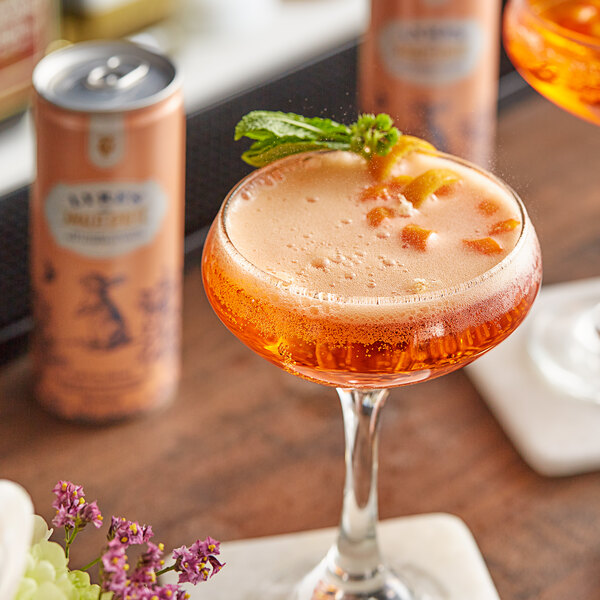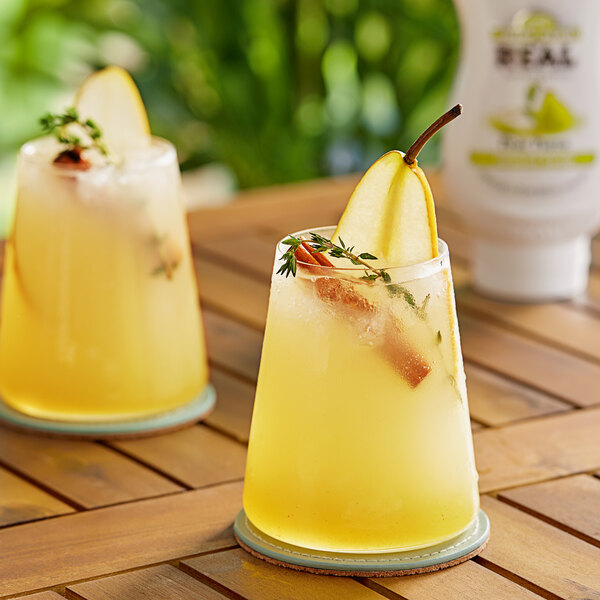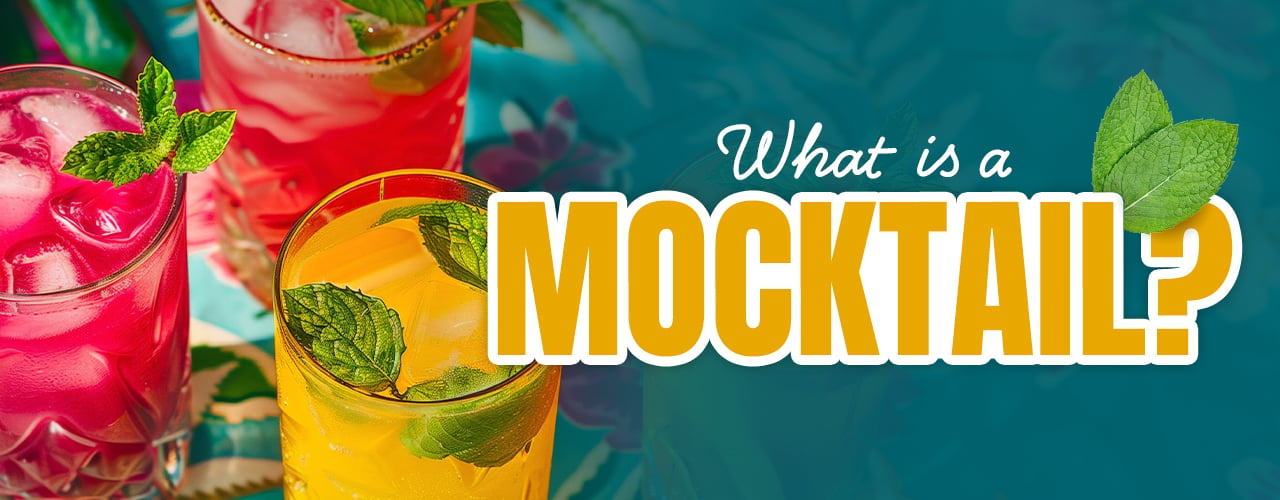Mocktails are alcohol-free beverages crafted to mimic traditional cocktails' appearance and intricate flavors. Using juices, herbs, and syrups, bartenders employ the same techniques and tools used in mixology to create these non-alcoholic concoctions. If you haven’t embraced this side of the bar industry yet, now is the perfect time. There is an increased trend towards no- and low-ABV drinks, and the number of premium cocktail syrups and mixers in unique flavors make creating craft beverages sans alcohol easier than ever before.
Shop All Non-Alcoholic DrinksMocktail vs Cocktail

Cocktails contain alcoholic spirits like vodka, rum, gin, or whiskey, which are the defining features of these mixed beverages. They’re known for their diverse flavor profiles, influenced by the type of alcohol used and the mixers and garnishes added to the drink. Mocktails are non-alcoholic beverages that rely on a combination of juices, syrups, herbs, and other ingredients to create complex flavors without including alcohol.
Cocktails are typically served at social gatherings, parties, and most types of bars where alcohol consumption is common. They are enjoyed by those looking to unwind and indulge in a flavorful alcoholic beverage. Mocktails are a popular choice for individuals who prefer not to consume alcohol, including designated drivers, pregnant women, and underaged patrons at a catered event. They’re also a great option for events where alcohol may not be appropriate or desired like a Quinceanera, bar mitzvah, or a baby shower.
What Is a Virgin Cocktail?
You’ll often hear mocktails called “virgin cocktails” because the two names are used interchangeably. Any beverage with an ABV level between 0 and 0.05% can be classified as a “virgin” drink. While you could technically call soda pop a virgin drink, you won’t see it referred to that way. We typically categorize mocktails and virgin drinks as mixed drinks that don’t contain alcohol. These types of drinks are becoming increasingly popular, as more consumers are looking to cut alcohol.
How to Make a Mocktail

While zero-proof liquors are becoming more popular and better tasting than ever before, the concept behind a traditional mocktail is creating a drink that is just as luxurious as a cocktail without alcohol. This mission is achievable without a substitute for alcohol. By following these steps, you can master the art of making delicious and visually appealing mocktails.
- Choose Your Base: Start by selecting a base for your mocktail. This can be fruit juice, soda, or flavored syrup. Consider using fresh ingredients like citrus fruits, berries, or herbs to enhance the flavor profile of your mocktail.
- Add Flavor Enhancers: To elevate the taste of your mocktail, consider adding flavor enhancers such as bitters, extracts, or infused syrups. These ingredients can add depth and complexity to your beverage. If desired, add a zero-proof liquor to mimic the taste of alcohol.
- Incorporate Sweeteners: Depending on the flavor profile you want to achieve, you may need to add sweeteners like simple syrup, honey, or agave nectar. Adjust the sweetness level to suit your customers' preferences.
- Consider Including Adaptogens: For patrons who want some relaxing/mood-altering effects without alcohol, consider incorporating adaptogenic ingredients into your mocktails. Adaptogens are plants and mushrooms that some believe help the human body adapt to stress, fatigue, and anxiety.
- Mix in Fresh Ingredients: Add visual appeal and earthy flavor to your mocktail by incorporating fresh fruits and herbs. These ingredients not only enhance the taste but also make your mocktail visually appealing.
- Shake or Stir: Once you have combined all the ingredients in a cocktail shaker or mixing glass, shake or stir the mixture to ensure that all the flavors are well combined. This step is crucial in achieving a well-balanced mocktail.
- Achieve the Ideal Serving Temperature: Most mocktails are best enjoyed cold but not too icy. The recommended temperature for serving mocktails is between 35 and 40 degrees Fahrenheit. Shake the mocktail over ice or add to an iced glass to create a refreshing and enjoyable drinking experience.
- Select Your Glassware: Using attractive glassware can elevate the visual appeal of your mocktail and make it more enticing to customers. Use cocktail glassware that complements the flavors and colors of the ingredients in your mocktail.
- Garnish with Style: The final touch to your mocktail is the garnish. Garnishes not only add visual appeal but can also enhance the aroma and taste of the drink. Consider using fresh fruit slices, edible flowers, or rimming salt as garnishes for your mocktail.

Mocktail Recipes
Don’t have time to develop your own mocktail recipes? We have you covered! Use our collection of mocktail recipes to build a non-alcoholic drink menu for patrons at your bar.
- Rainbow Breeze Mocktail Recipe
- Blackberry Mule Mocktail Recipe
- Lemongrass Basil Mocktail
- Agua Fresca Recipe
- Mangonada Recipe
What Is a Sober Bar?
As the trend towards mindful drinking and eliminating alcohol consumption grows, mocktails have grown in popularity, leading to the emergence of non-alcoholic bars specializing in zero-proof drinks. These locations have been affectionately termed sober bars. They typically have an extensive menu of mocktails to choose from. In a mocktail bar, you can have a great alternative bar experience and order delicious non-alcoholic drinks.
Consider creating a mocktail menu to accompany your cocktail list. More consumers are choosing to limit their alcohol consumption or abstain completely, making mocktail recipes more prevalent in the bar scene. An exciting list of craft mocktails ensures that everyone can enjoy a flavorful, refreshing beverage when they visit your bar or restaurant.
Related Resources

Super Juice: A Bartending Hack
Super juice isn't a wellness fad or a green juice recipe; it's a method of extending your fresh citrus juice so that you get more for your money. Usually, citrus peels are tossed out in the trash. With super juice, the peels are combined with the juice to create a sustainable cocktail ingredient. This bartending hack is a cost-effective way to extend your fresh produce while saving time behind the bar. Keep reading to learn more about super juice and how you can make your own. What Is Super Juice? Super juice, also called oleo citrate, is an emulsification of citrus juice, peels, citric acid, malic acid, and water. It may sound scientific, but the result is a great-tasting citrus product that gives you up to 8 times more juice than squeezing or pressing alone. It also lasts a week or more in the fridge, which makes it a convenient bar ingredient to use for cocktails. Super juice can be used in margaritas or any beverage that features fresh citrus juice. Keep in mind that super juice is a fresh juice product with a high-quality citrus flavor. It's not the same thing as bottled lime juice that contains preservatives, even though it provides the same benefits, like a long shelf-life. What Are Malic Acid and Citric Acid? Two of the ingredients used to make super juice are malic acid and citric acid. These crystalline powders have a sour and acidic taste that makes them ideal flavor enhancers. Citric acid is commonly used as a preservative, baking ingredient, and candy coating. You can purchase citric acid where you buy wholesale spices. Malic acid is often used in the production of beverages such as fruit juices, energy drinks, and sodas. It helps to provide a refreshing tartness and can enhance the overall flavor profile of the drink. Shop for malic acid online or at specialty stores. Both citric acid and malic acid are key components to making super juice. Who Invented Super Juice? Bartenders and mixologists have been playing around with methods of preserving lime juice for several years. The collective knowledge of these pioneers has resulted in the discovery of super juice in different forms. Nickle Morris, a Kentucky-based bartender and owner introduced his recipe for super juice in a YouTube video in 2020. Since then, many videos with variations on the recipe have followed. Even though no one is gatekeeping this recipe, super juice remains a bit of an industry secret. We think it deserves to be shared with all bartenders because it's truly a game-changer. Why Should I Try Super Juice? Now that you know what it is and where it comes from, you may be wondering why super juice is so special. Here are a few reasons you should try super juice for yourself: Fresh Flavor: Unlike bottled juice products, super juice preserves the fresh flavor of the juice, which is very different than bottled juices that contain sulfites. Bottled pasteurized lime juice has its place and comes in handy for a range of recipes, but when you're crafting a cocktail, the flavor of fresh citrus is incomparable. It shines through, simultaneously enhancing and balancing the drink. Affordability: If you're looking for ways to cut food cost, you've found one. Fresh produce can be an expensive part of your budget, and with super juice, you get more juice with less product. Sustainability: Peels and rinds account for a large portion of the waste material from citrus fruits that makes it to the landfill. Instead of creating more food waste, you can use citrus peels to make super juice. Shelf-Life: Fresh lime juice or lemon juice has to be used within a couple of days, but super juice can last up to 10 days. If you make a large batch of super juice and freeze it, it can last even longer. This is extremely convenient for bartending and helps you skip the juicing step. Super Lime Juice Recipe You can make super juice from any type of citrus, and you only need a few tools: an immersion blender, a citrus peeler, and a citrus squeezer. Our recipe below is for limes since lime juice is a common bartending essential. Yield: 4 cups Prep Time: 75 minutes Ingredients 8 limes 44 grams citric acid 8 grams malic acid 4 cups water Directions Peel limes and add peels to large container. Add citric acid and malic acid to container. Muddle peel mixture with muddler or back of large spoon. Let mixture sit for one hour. Meanwhile, juice all peeled limes and set aside. After one hour, add juice and water to peel mixture and blend with immersion blender until smooth. If preferred, use fine strainer to remove solids. Refrigerate super juice mixture for up to 7-10 days. Use in place of lime juice in any cocktail! Can You Make Super Juice with Lemons? Yes, you can adapt this recipe for any type of citrus, including lemons. Just swap out the 8 limes in the recipe above for 6 lemons and proceed with the same directions. Can You Freeze Super Juice? Yes, you can freeze super juice to make it last even longer. Place the juice in a freezer-safe container and freeze for up to 6 months. Instead of squeezing lemons and limes for every drink, try making a batch of super juice. You'll save time, money, and effort while crafting delicious cocktails with bright citrus flavors. Super juice can be added to margaritas, mojitos, and any drink that features lemon or lime juice.

The Top 10 Cocktail Bitters Every Bar Needs
If you want to create an upscale cocktail menu, investing in popular, high-quality bitters is essential. Made by infusing herbs spices, and other botanicals in alcohol, bitters are concentrated flavor extracts that add depth and complexity to cocktails. They also play a crucial role in crafting a flavorful mocktail, helping compensate for the lack of liquor. From earthy to sweet, there are a wide variety of bitters to choose from. We’ve compiled a list of the top 10 most popular bitters flavors bars should invest in and the brands they should know. Shop All Bitters Learn more about the most popular bitters: 1. Orange Bitters 2. Aromatic Bitters 3. Chocolate Bitters 4. Lavender Bitters 5. Cherry Bitters 6. Peach Bitters 7. Grapefruit Bitters 8. Celery Bitters 9. Vanilla Bitters 10. Lemon Bitters 11. Best Bitters Brands 1. Orange Bitters Orange bitters are made from a combination of ingredients such as orange peels, cardamom, caraway seed, coriander, anise, and burnt sugar. With its citrusy and spicy notes, these complex and aromatic bitters enhance the taste of a wide range of cocktails. Orange bitters are commonly used to put a twist on classic cocktails such as the Manhattan and the martini, and they can also be a versatile addition to modern mixology creations. Orange Bitters Tasting Notes: Fruity, spicy, bitter orange peel, zesty orange juice, herbal notes Liquors Orange Bitters Complement: Vodka, whiskey, gin, tequila, rum Best Cocktails for Orange Bitters: Pegu Club, Bijou, Old Fashioned, Black Manhattan, Zombie 2. Aromatic Bitters Aromatic bitters are typically reminiscent of warm baking spices such as cinnamon, cardamom, anise, and cloves, along with dried fruits and citrus peel, offering a harmonious balance of sweet and tangy notes. They also feature a subtle wood finish, which adds a touch of earthiness to cocktails. Well-suited for rum and different types of whiskey drinks, aromatic bitters impart a rich and robust flavor that complements the boldness of these spirits. Aromatic Bitters Tasting Notes: Baking spices, dried fruits, wood finish Liquors Aromatic Bitters Complement: Whiskey, gin, rum, vodka Best Cocktails for Aromatic Bitters: Trinidad Sour, Port of Spain, Queen’s Park Swizzle, Pink Gin, Old Fashioned, Sazerac, Manhattan 3. Chocolate Bitters Chocolate bitters are known for their deep chocolate flavor profile, hints of vanilla and cinnamon, and bitter elements such as gentian and wormwood, which provide a balanced and nuanced flavor profile. Chocolate bitters are typically made with cacao nibs, which are the raw form of chocolate without added sugar. This results in a bittersweet taste that adds depth and complexity to cocktails (chocolate frozen espresso martini anyone?) without making them overly sweet. Chocolate bitters are not limited to cocktails alone; they can also be used in desserts to add a unique twist to classic recipes. Chocolate Bitters Tasting Notes: Unsweetened cacao, vanilla, cinnamon, wormwood Liquors Chocolate Bitters Complement: Sweet vermouths, whiskey, rum, brandy Best Cocktails for Chocolate Bitters: Chocolate Martini, Chocolate Old Fashioned, Chocolate Espresso Martini, Chocolate Manhattan 4. Lavender Bitters Whether you're looking to add a touch of floral elegance to your cocktails or experiment with new flavor profiles, lavender bitters are a must-have ingredient for any bar. Known for their bright lavender flavor, these bitters often include a blend of fresh herbs, spices, and citrus zest. The floral notes of lavender bitters bring a delicate and aromatic quality to cocktails. Lavender bitters can enhance the botanicals in gin-based cocktails, add a refreshing twist to vodka drinks, or bring a subtle complexity to beverages with tequila bases. Lavender Bitters Tasting Notes: Floral lavender, fresh herbs, citrus zest Liquors Lavender Bitters Complement: Gin, vodka, tequila Best Cocktails for Lavender Bitters: Spiked Lemonade, Lavender Gin and Tonic, Lavender French 75, Lavender Bee’s Knees 5. Cherry Bitters Made from the essence of sweet or sour cherries, these bitters offer a delightful combination of fruity and spiced flavors that can elevate the taste of many cocktails. They can pair well with both light and dark liquors, making them a versatile ingredient in a bartender's toolkit. The distinct spiced cherry notes in cherry bitters come from the infusion of botanicals like cherry bark during the production process, resulting in a complex flavor profile that adds depth and richness. Cherry bitters are particularly well-suited for updating classic cocktails like the Old Fashioned or Manhattan, where their bold flavor can shine through. Cherry Bitters Tasting Notes: Ripe cherries, floral aroma, a balance of sweet, sour, and bitter flavors Liquors Cherry Bitters Complement: Rum, whiskey, bourbon, vodka, gin Best Cocktails for Cherry Bitters: Cherry Old Fashioned, Cherry Manhattan, Cherry Gin Rickey, Cherry Gin Fizz, Cherry Negroni, Cherry Bramble 6. Peach Bitters Peach bitters are known for their juicy, sweet peach flavor that pairs exceptionally well with a variety of spirits, including bourbon, rum, whiskey, tequila, brandy, and cognac. Ideal for creating high-quality craft cocktails and mocktails, peach bitters can add a refreshing flavor to classic recipes. In addition to the prominent peach flavor, these bitters may also include complementary notes of almond, citrus, and herb flavors, enhancing the complexity of the drink. Experiment with different combinations to discover the perfect balance of sweet and savory notes in your drinks. Peach Bitters Tasting Notes: Ripe cherries, floral aroma, a balance of sweet, sour, and bitter flavors Liquors Peach Bitters Complement: Bourbon, rum, whiskey, tequila, brandy, and cognac Best Cocktails for Peach Bitters: Spiked Iced Tea, Bellini-Tini, Greenbriar, Peach Old Fashioned, La Bicyclette, Bourbon Peach Smash, Byrrh 7. Grapefruit Bitters Grapefruit bitters are known for their refreshing, bittersweet grapefruit flavor that adds a citrusy kick to your drinks. They pair exceptionally well with vodka, tequila, mezcal, or gin, enhancing the overall taste profile of your cocktails. Try adding a dash to our spicy grapefruit mezcal margarita recipe. In addition to their citrusy flavor, grapefruit bitters can also contain floral notes such as gentian flower or lavender, as well as herbal notes like rosemary. These additional flavor layers can elevate your cocktails' complexity, creating a well-balanced and aromatic drinking experience. It's important to note that a little bit of grapefruit bitters goes a long way, so bartenders should use them sparingly to avoid overpowering the drink. Grapefruit Bitters Tasting Notes: Grapefruit, citrus fruits, herbs and spices, occasional floral notes Liquors Grapefruit Bitters Complement: Vodka, tequila, mezcal, gin Best Cocktails for Grapefruit Bitters: Tenner Martini, Paloma, Death in Venice, Greyhound, Sunstroke 8. Celery Bitters In addition to their distinctive celery taste, these bitters often contain notes of lemongrass, ginger, licorice root, or black pepper, adding layers of depth and complexity to your beverages. Celery bitters pair exceptionally well with vodka, tequila, gin, or other light spirits, adding a crisp and refreshing element to your drinks. Whether you're looking to enhance a Bloody Mary or experiment with new flavor profiles, celery bitters are a must-have ingredient for any bartender looking to take their mixology skills to the next level. Celery Bitters Tasting Notes: Earthy celery, lemongrass, ginger, licorice root, black pepper Liquors Grapefruit Bitters Complement: Vodka, tequila, gin Best Cocktails for Grapefruit Bitters: Ephemeral Cocktail, Celery Daquiri, Bloody Mary, Celery Vesper Martini, Loop Tonic Cocktail, Fourth Regiment Cocktail 9. Vanilla Bitters All vanilla bitters contain premium vanilla as a key ingredient, which imparts a rich and aromatic flavor profile to drinks. Many vanilla bitters are bourbon barrel-aged, adding depth and complexity to the flavor profile. In addition to vanilla, these bitters often contain complementary flavors such as cherry, star anise, cocoa, orange, maple, or almond. These additional flavors enhance the overall taste of the bitters and provide a well-rounded experience. Vanilla bitters complement a wide range of spirits but pair particularly well with bourbon, rye whiskey, or gin. Vanilla Bitters Tasting Notes: Vanilla bean and complementary flavors such as cacao, almond, or star anise depending on the brand Liquors Vanilla Bitters Complement: Bourbon, rye whiskey, gin Best Cocktails for Vanilla Bitters: El Sueno Cocktail, Bourbon Vanilla Manhattan, Chilean Monkey Tail Punch, Vanilla Bean Old Fashioned, Vanilla Rum White Russian 10. Lemon Bitters The bright citrus flavor of lemon bitters adds a zesty kick to drinks, enhancing their overall taste profile. These bitters pair best with light-colored spirits such as vodka, tequila, and gin. From spiked iced teas and lemonades to limoncello margaritas and lemon spritz, lemon bitters are a perfect addition when you're creating summery cocktails. Many brands pair florals and spices to enhance the flavor profile of their lemon bitters. Lemon Bitters Tasting Notes: Bright citrus, lemon zest, bitter lemon Liquors Lemon Bitters Complement: Vodka, tequila, gin Best Cocktails for Lemon Bitters: Lemon Lime and Bitters Cocktail, Spiked Iced Tea, Spiked Lemonade, Limoncello Margarita, Lemon Spritz, Basil Lemon Margarita, Lemon Lavender Gin and Tonic Back to Top Bitters Brands While you can make your own cocktail bitters, it’s a time-consuming process most bar operators can’t take upon themselves. Thankfully, many exemplary brands have won the trust and respect of bartenders over the years. Before stocking up on bar essentials, review our information on prominent bitters brands to make an informed purchasing decision. Angostura Angostura is a widely recognized producer of aromatic bitters with a rich history dating back to the 1870s when Dr. Johann Siegert created bitters as a medicinal remedy for stomach ailments. Although Angostura bitters are no longer used for medicinal purposes, they have found a new role in the culinary world. These bitters are often incorporated into cooking recipes and are particularly popular in cocktail making, such as in crafting classic Manhattans and Old Fashioneds. Price Point: $8.89 - $31.99 Flavors: Aromatic bitters, orange bitters, cocoa bitters Sizes Available: 4 fl. oz. - 16 fl. oz. See what our customers are saying about Angostura bitters! Fee Brothers Established in 1864, Fee Brothers is a family-owned business renowned for crafting premium drink flavorings and mixes. Originally founded as a winemaking and liquor import enterprise, the company transitioned in the 1950s to primarily offer non-alcoholic products that had surged in demand since the Prohibition era. The dedication and enthusiasm invested in bottling each Fee Brothers product have been consistently upheld over the years, solidifying its reputation as a respected and reliable brand within the cocktail-making sphere. Price Point: $8.69 Flavors: Aromatic bitters, cardamon bitters, cherry bitters, chili bitters, chocolate bitters, grapefruit bitters, orange bitters, lemon bitters, vanilla bitters Sizes Available: 5 fl. oz See what our customers are saying about Fee Brothers bitters! Woodford Reserve Situated on the historic grounds of Kentucky's oldest distillery where Elijah Pepper began crafting whiskey in 1812, Woodford Reserve stands as one of the oldest and smallest distilleries in the United States. Woodford Reserve has formed a proud partnership with Bourbon Barrel Foods, offering a range of cocktail and culinary mixes. By using Woodford Reserve's bitters and concentrated flavors, you can elevate the taste of your cocktails. Price Point: $9.49 Flavors: Aromatic bitters, cherry bitters, chocolate bitters, orange bitters, herbs and spices, peach bitters Sizes Available: 1.7 fl. oz - 2 fl. oz. See what our customers are saying about Woodford Reserve bitters! King Floyd’s King Floyd's Bar Provisions specializes in creating distinctively flavored bitters. Their dedication to perfection is evident in their meticulous approach, starting from selecting premium ingredients to maintaining uniform quality. By allowing time and nature to enhance the flavors, King Floyd's achieves a truly authentic taste that sets them apart. Transform your drinks into sophisticated, rich cocktails with King Floyd's exceptional flavors. Price Point: $9.49 Flavors: Aromatic bitters, cherry bitters, chocolate bitters, orange bitters, ginger bitters, grapefruit bitters, pear bitters, herbs and spices, plum rosemary bitters Sizes Available: 1.7 fl. oz - 2 fl. oz. See what our customers are saying about King Floyd’s bitters! Back to Top Elevate your cocktail menu and impress your customers with the addition of top-quality cocktail bitters to your bar arsenal. Whether you are looking to add depth and complexity to classic cocktails or experiment with new flavor combinations in innovative creations, cocktail bitters are a versatile ingredient that can enhance the overall drinking experience. With a wide range of options available, from traditional aromatic bitters to exotic and bold flavors, there is something to suit every taste preference and style of establishment.

How to Run a Successful Bar
Starting a new bar comes with its unique set of challenges. Once it is off the ground, keeping it successful requires a combination of strategic planning, efficient operations, and exceptional customer service. From creating a unique atmosphere to curating a diverse drink menu, every aspect of a bar's operation plays a crucial role in attracting and retaining customers. By focusing on proper inventory management, staff training, and marketing, bar owners can ensure a memorable and enjoyable experience to keep their patrons coming back for more. Shop All Bar Supplies Use the following links to jump to a specific bar management tip: Inventory Management Bar Cleanliness Marketing Opportunities Hiring and Training Drink Menu Events at Your Bar POS System and Tech Liabilities Bar Management Tips Whether you own a brewery or sports bar, these tips can help you keep your bar thriving for years to come. Success for some is monetary. For others, it is brand recognition, or it could be customer satisfaction. We created a list of tips to produce the most well-rounded successful operation in today's competitive market. 1. Stay on Top of Inventory Management Running a successful bar involves keeping a close eye on your inventory. Regularly tracking the quantities of your stock will help you identify which items are selling well and which ones may be sitting on the shelves for too long. By staying on top of inventory, you can reduce food and beverage waste, saving you money in the long haul. Bar inventory shrinkage—the loss of inventory due to theft—spillage, or errors, can significantly impact a bar's profitability. On average, bars experience a 20-25% shrinkage rate, with the most common causes being overpouring, employee theft, and administrative errors. By implementing strict inventory control measures, you can optimize your operations, improve customer satisfaction, and maximize your profitability. Conduct Regular Inventory Checks: Regularly audit your bar inventory to ensure that all items are accounted for to identify any discrepancies or potential losses promptly. Keep track of the usage of different types of alcohol and mixers to anticipate demand and prevent running out of popular items. This can help optimize your purchasing decisions and maintain a well-stocked bar. Implement Inventory Management Systems: Utilize inventory management software or systems to track your stock levels accurately. These tools can help in automating inventory counts and generating reports for better decision-making. Train Staff on Pouring Techniques: Train your bartenders on proper pouring techniques to minimize overpouring and ensure consistent drink quality. Implementing measured pour spouts can also help control portion sizes. Stock Up Regularly on Essentials: To ensure that you meet the demands of your customers and maintain a smooth operation, it is crucial to stock up on bar essentials. This includes popular liquors, mixers, garnishes, glassware, and other key items that are essential for serving a wide range of beverages. Identify your best-selling items and ensure that you have an adequate supply of these essentials at all times. Create a restocking schedule to replenish inventory before it runs low to avoid stockouts. 2. Prioritize Bar Cleanliness Maintaining a clean and sanitary bar environment is crucial for running a successful bar operation. Not only does cleanliness contribute to the overall customer experience, but it also ensures compliance with health and safety regulations. Here are some key facts to consider when prioritizing bar cleanliness: Regular Cleaning Schedule: Establishing a routine cleaning schedule is essential for keeping your bar area spotless. Daily tasks should include wiping down surfaces, cleaning glassware, and sanitizing equipment. Additionally, weekly deep cleanings should be conducted to address hard-to-reach areas and prevent the buildup of grime and bacteria. Proper Sanitization: Effective sanitization is critical in preventing the spread of germs and maintaining a hygienic bar environment. Use commercial-grade disinfectants to clean surfaces, bar tools, and equipment regularly. Pay special attention to high-touch areas such as bar tops, door handles, and restroom facilities. Regularly clean your soda guns and sanitize your keg lines to serve the best-tasting drinks at your bar. Organized Storage: Maintaining organized storage areas for liquor bottles, glassware, and bar supplies not only improves efficiency but also contributes to cleanliness. Properly labeled containers, shelving units, and storage racks help prevent clutter and make it easier to keep track of inventory and cleaning supplies. Staff Training: Investing in staff training on proper cleaning procedures and hygiene practices is essential for upholding cleanliness standards in your bar. Ensure that all employees are familiar with cleaning protocols, sanitation guidelines, and the importance of maintaining a clean workspace. Attention to Detail: Paying attention to small details can make a big difference in the cleanliness of your bar. Regularly inspecting for spills, stains, and debris, as well as promptly addressing any issues, helps maintain a pristine appearance and demonstrates your commitment to cleanliness to both customers and health inspectors. 3. Invest in Marketing Opportunities <figure class="article-image"> </figure> Successfully promoting your bar is crucial for attracting and retaining customers. Investing in various marketing opportunities can help increase brand visibility, drive foot traffic, and differentiate yourself from competitors in the industry. Stay creative and open to new ideas to continuously engage with your audience and drive business growth. Consider incorporating the following strategies into your marketing plan: Social Posts: Utilize social media platforms such as Instagram, Facebook, and Twitter to engage with your audience and promote your bar. Regularly posting updates, specials, and events can help create buzz and attract new customers. Email Blasts: Build an email list of loyal customers and send out regular newsletters with updates on upcoming events, promotions, and new menu items. Personalized email blasts can help keep your bar top of mind for customers. Customized Merchandise: Create branded merchandise such as t-shirts, hats, or glassware that customers can purchase or receive as promotional items. This not only serves as a revenue stream but also helps promote your bar outside of your physical location. Radio Appearances: Consider partnering with local radio stations to promote your bar through on-air appearances or advertisements. Radio is a powerful medium to reach a wide audience and can help increase brand awareness in your community. Brand Collaborations: Collaborate with other businesses or influencers to cross-promote each other's brands. Partnering with a local brewery for a tap takeover event or teaming up with a popular food truck can help attract new customers and create a unique experience for your patrons. Sponsorships: Sponsor local events, sports teams, or community organizations to increase your bar's visibility and support your community. Sponsorship opportunities can help build goodwill and strengthen relationships with customers. 4. Be Intentional with Hiring and Training The bar industry has a very high turnover rate, which results in lots of money wasted on training new employees. Your bar can prevent this by implementing strict standards when hiring and creating a rigorous training regimen that weeds out any poor fits early in the process. Once you have a strong team, remember to invest in them through training and promotional opportunities. Hire Eager Individuals: When building your team, look for individuals who are eager to learn and grow within the industry. A positive attitude and willingness to take on new challenges can go a long way in creating a dynamic and motivated staff. Look to hire bartenders who not only have drink-making skills but are versed in customer service as well. Train Bartenders and Wait Staff to Upsell: Upselling is a valuable skill that can help increase revenue and enhance the customer experience. Provide training to your bartenders and wait staff on effective upselling techniques, such as suggestive selling and recommending premium products. Framing the sale as a suggestion will make your customers more likely to try the more expensive option. Boost sales by offering food and drink pairings based on common flavors or contrasts. Train staff to detect undecided customers. If someone has glanced at their menu for an extended period of time, a simple "Can I suggest one of our specials?" can help sway them. Offer Bonuses and Incentives for Excellent Performance: Recognizing and rewarding exceptional performance can boost employee morale and motivation. Consider implementing a bonus or incentive program based on sales performance, customer satisfaction, or other key metrics to encourage your staff to excel in their roles. One of the best ways that bar managers can retain good employees is with incentives, such as bonuses, favorable shifts, promotions, or pay raises. Regularly Train Employees on New Skills: The food and beverage industry is constantly evolving, with new trends and technologies shaping the way businesses operate. Keep your staff up-to-date by providing regular training sessions on new skills, products, and industry best practices to ensure they are equipped to deliver top-notch service to your customers. If you have a dishwasher who is dedicated to working hard but who also wants to learn bartending skills, reward them by offering some training and allowing them to bartend during slow periods of business at first. 5. Update Your Drink Menu To stay ahead in the competitive bar industry, it's essential to constantly update your drink menu to keep customers engaged and interested. By updating your drink menu with new and innovative offerings, you can attract new customers and keep existing ones coming back for more. These are just some ways you can keep your menu fresh: Keep Up with Bar Trends: Keeping up with the latest bar trends is crucial to ensuring that your drink menu remains relevant and appealing to customers. Stay informed about popular cocktail ingredients, flavor profiles, and presentation styles to incorporate fresh ideas into your menu. Monitor industry publications, attend trade shows, and follow social media influencers to discover emerging trends. Whether it's the resurgence of classic cocktails or the introduction of innovative mixology techniques, being aware of current trends can give your bar a competitive edge. Create a Signature Cocktail: Developing a signature cocktail is a great way to showcase your bar's unique identity and stand out from the competition. Consider incorporating unique ingredients, innovative techniques, or a creative presentation to make this drink a standout feature on your menu. Develop a drink that reflects the personality of your establishment, whether it's a creative twist on a classic cocktail or a completely original creation. A signature cocktail can become a customer favorite and even a must-try item that sets your bar apart. Promote it through social media, menu placement, and special promotions to drive customer interest and sales. Add Mocktails to the Menu: Appeal to a wider audience by including mocktails and zero-proof drinks on your drink menu. Mocktails are non-alcoholic beverages that are crafted with the same attention to detail as cocktails, offering flavorful and refreshing options for customers who prefer not to drink alcohol. Non-alcoholic options are increasingly popular among customers who are looking for flavorful, alcohol-free alternatives. Create mocktail versions of popular cocktails or develop unique non-alcoholic recipes that showcase fresh ingredients and creative flavor combinations. By including mocktails on your menu, you can accommodate designated drivers, non-drinkers, and those looking for a lighter alternative. 6. Host Events at Your Bar Hosting events at your bar can be a great way to attract customers, create a lively atmosphere, and increase revenue. These events give your customers something to look forward to, talk about, and invite their friends to. Here are some popular event ideas to consider implementing at your bar: Happy Hour: Offering a happy hour with discounted drinks and appetizers is a classic way to draw in customers during slower times. Promote your happy hour specials on social media and through flyers to attract a larger crowd. Your happy hour menu should feature discounts on items with a high-profit margin, group specials, snacks, and designated driver discounts to maximize your profits. Trivia Nights: Hosting trivia nights is a fun and interactive way to engage your customers. Consider offering prizes for the winning team to encourage participation and keep patrons coming back for more. Speed Dating Event: Organizing a speed dating event can be a unique and exciting way to bring people together and create a fun and social atmosphere at your bar. Partner with a local speed dating company to help organize and promote the event. Karaoke and Open Mic Nights: Karaoke and open mic nights are always a hit with customers looking to showcase their talents or simply enjoy some entertainment. Encourage customers to participate and create a welcoming and inclusive environment for performers and spectators alike. Televise Sporting Events: Broadcasting popular sporting events at your bar can attract sports fans and create a lively and energetic atmosphere. Consider offering food and drink specials during the event to enhance the viewing experience for customers. Market sporting events ahead of time to attract to your bar on game night. Participate in a Bar Crawl: Joining a bar crawl in your area can help expose your bar to new customers and increase visibility within the community. Collaborate with other bars in the area to create a fun and memorable bar crawl experience for participants. Invite Local Bands and Artists: Hosting live music events featuring local bands and artists can help attract a diverse crowd and create a vibrant and dynamic atmosphere at your bar. Consider creating a regular schedule of live music performances to keep customers coming back for more. 7. Invest in a POS System and Tech In today's fast-paced bar industry, having the right technology can make a significant difference in the efficiency and success of your establishment. One crucial investment for running a successful bar is a Point of Sale (POS) system. A POS system streamlines the ordering process, tracks sales data, manages inventory, and helps you make informed decisions to optimize your business operations. When selecting a POS system for your bar, consider factors such as ease of use, scalability, reporting capabilities, and customer support. Here are just some of the benefits of choosing an up-to-date POS system for your bar: Improved Efficiency: A POS system allows your staff to take orders quickly and accurately, reducing wait times for customers. It also enables seamless communication between the front and back of house, ensuring smooth operations during busy hours. Sales Tracking: With a POS system, you can easily track sales trends, identify top-selling items, and analyze customer preferences. This data can help you make data-driven decisions about pricing, promotions, and menu offerings. Inventory Management: Keeping track of inventory levels manually can be time-consuming and prone to errors. A POS system automates inventory management by tracking stock levels in real time, generating alerts for low-stock items, and helping you optimize your ordering process. Customer Relationship Management: Many POS systems offer customer management features that allow you to track customer preferences, create loyalty programs, and send targeted promotions. Building strong relationships with your customers can lead to repeat business and increased revenue. Integration with Other Technologies: A modern POS system can integrate with various technologies such as payment processors, online ordering platforms, and kitchen display systems. This integration streamlines operations and enhances the overall customer experience. 8. Take Liabilities Seriously Alcohol service is a risky business. When managing a bar, you should train staff to handle alcohol-related safety issues, not just for the safety of customers who have consumed too much alcohol, but to protect your bar from fines, imprisonment, loss of liquor license, increased insurance costs, and even losing your business. These are some common safety procedures to train your staff to perform: Detect Fake IDs: Spotting fake IDs is a crucial aspect of running a successful bar. It is essential to train your staff to carefully examine identification cards to ensure that they are legitimate. Refusing to serve minors is not only a legal obligation but also a moral responsibility. By strictly adhering to age verification protocols and refusing service to individuals who cannot provide valid identification, you uphold the integrity of your establishment and protect both your customers and your business. Utilizing tools such as UV lights and ID scanning devices can further assist in detecting fraudulent IDs and preventing underage drinking. Understand Angel Shot Protocols: Offering angel shots is a proactive approach to ensuring the safety of your patrons. This discrete signal allows customers to secretly communicate with your staff if they feel uncomfortable or unsafe in a social situation. By providing this option, you create a safer environment for all patrons and demonstrate your commitment to their well-being. Cut Excessively Intoxicated Patrons Off: Knowing when to cut patrons off is a critical skill that every bartender and server should possess. Monitoring the behavior of customers and recognizing signs of intoxication is essential in preventing overconsumption and potential harm. By intervening when necessary and responsibly managing alcohol service, you protect both your customers and your business from liability issues. The bar industry is very competitive, and it can be difficult to run a bar successfully due to the razor-thin profit margins. But, by taking a more active role in your business, ensuring that your bar is stocked with everything it needs, and training your employees for success, you can help your bar become profitable and succeed.





